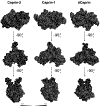Crystal structure of a dimerization domain of human Caprin-2: similar overall dimeric fold but different molecular surface properties to that of human Caprin-1
- PMID: 30304999
- PMCID: PMC6459735
- DOI: 10.1080/07391102.2018.1532817
Crystal structure of a dimerization domain of human Caprin-2: similar overall dimeric fold but different molecular surface properties to that of human Caprin-1
Abstract
Human Caprin-1 and Caprin-2 are prototypic members of the caprin (cytoplasmic activation/proliferation-associated protein) protein family. Vertebrate caprin proteins contain two highly conserved homologous regions (HR1 and HR2) and C-terminal RGG motifs. Drosophila caprin (dCaprin) shares HR1 and RGG motifs but lacks HR2. Caprin-1 and Caprin-2 have important and non-redundant functions. The detailed molecular mechanisms of their actions remain largely unknown. Previously, we determined the crystal structure of a ∼120-residue fragment of Caprin-1 within the HR1 region. The structure has a novel all α-helical fold that self-associates to form a homodimer. In this study, the crystal structure of a corresponding fragment from Caprin-2 is reported. The Caprin-2 fragment has similar protein fold and dimeric structure as that of the Caprin-1 fragment. Structural comparison reveals that the molecular interactions mediating homodimerization of Caprin-1 and Caprin-2 are largely conserved in the two systems. Structural-modelling study of the corresponding dCaprin fragment indicates that dCaprin may also adopt a similar dimeric structure. The presence of a dimerization domain within HR1 may represent an evolutionarily conserved feature of the caprin protein family. Interestingly, while Caprin-1 and Caprin-2 adopt similar overall dimeric structures, the two structures have quite different molecular surface properties. In the Caprin-1 dimeric structure, some of the surface areas are known or suspected to function as binding sites for Carpin-1-interacting proteins. The different surface properties of the caprin dimeric structures may dictate their intermolecular interaction with specific protein partners. Communicated by Ramaswamy H. Sarma.
Keywords: Caprin-1; FMRP; G3BP1; RNA stress granule; caprin-2.
Figures





References
Publication types
MeSH terms
Substances
Grants and funding
LinkOut - more resources
Full Text Sources
Molecular Biology Databases
Miscellaneous
